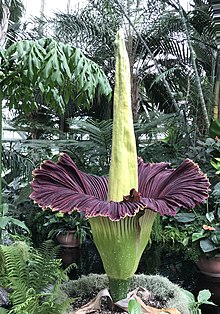| Amorphophallus titanum | |
|---|---|

| |
| In bloom at New York Botanical Garden June 27, 2018 | |
| Scientific classification | |
| Kingdom: | Plantae |
| Clade: | Tracheophytes |
| Clade: | Angiosperms |
| Clade: | Monocots |
| Order: | Alismatales |
| Family: | Araceae |
| Genus: | Amorphophallus |
| Species: | A. titanum
|
| Binomial name | |
| Amorphophallus titanum (Becc.) Becc. ex Arcang
| |
| Synonyms | |
| |
Amorphophallus titanum, the titan arum, is a flowering plant in the family Araceae. It has the largest unbranched inflorescence in the world. The inflorescence of the talipot palm, Corypha umbraculifera, is larger, but it is branched rather than unbranched. A. titanum is endemic to rainforests on the Indonesian island of Sumatra.
Because its flower blooms infrequently and only for a short period, it gives off a powerful scent to help attract pollinators quickly and effectively.[2] The strong odor it emits resembles that of rotting flesh; hence it is characterized as a carrion flower and is also known as the corpse flower or corpse plant, as translated from the original Indonesian word bunga bangkai (bunga means flower, while bangkai can be translated as corpse, cadaver, or carrion).
The titan arum's berries arrange in a regular cylindrical form that resembles the packing of spheres inside a cylindrical confinement. Those structures are also called columnar structures or crystals.
- ^ Yuzammi.; Hadiah, J.T. (2018). "Amorphophallus titanum". IUCN Red List of Threatened Species. 2018: e.T118042834A118043213. doi:10.2305/IUCN.UK.2018-2.RLTS.T118042834A118043213.en. Retrieved 1 May 2023.
- ^ Bradford, Alina; published, Daisy Dobrijevic (2021-10-27). "Corpse Flower: Facts About the Smelly Plant". livescience.com. Retrieved 2024-04-28.
